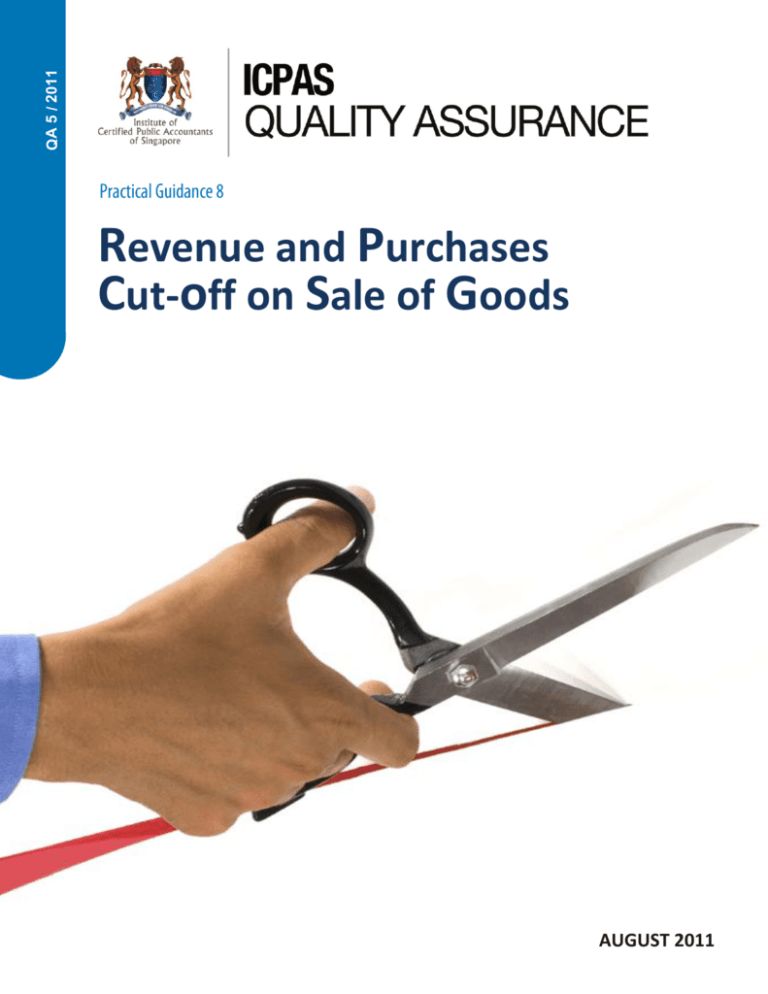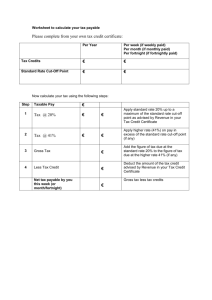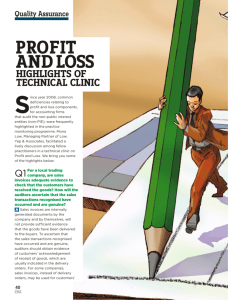
QA 5 / 2011
Revenue and Purchases
Cut-off on Sale of Goods
AUGUST 2011
INTRODUCTION
1. Financial Reporting Standard (“FRS”) 18 “Revenue”
states that for sale of goods, one of the criteria to
recognise revenue is when the entity has transferred
to the buyer the significant risks and rewards
associated with ownership of the goods (FRS 18,
paragraph 14a). There could be instances where
companies recognise revenue and purchases based
on the date of sales invoices or supplier invoices
respectively without taking into consideration the
requirements of FRS 18 as mentioned above and this
could potentially lead to improper cut-off of revenue
and purchases at year-end, resulting in
misstatements of the financial statements. Hence,
proper revenue and purchases cut-off tests at yearend are critical in addressing the cut-off assertion for
sales and purchases.
2. The aim of this Practical Guidance is to provide
auditors with some guidance when performing sales
and purchases cut-off procedures for companies
engaged in local and/or overseas trading sales of
goods.
GUIDING PRINCIPLE
3. FRS 18 states that revenue from the sale of goods
should be recognised when the entity has transferred
to the buyer the significant risks and rewards of
ownership of the goods (FRS 18, paragraph 14a).
4. FRS 18 also further explains that the assessment of
when an entity has transferred the significant risks
and rewards of ownership to the buyer requires an
examination of the circumstances of the transaction.
In most cases, the transfer of the risks and rewards of
ownership coincides with the transfer of the legal
title or the passing of possession to the buyer. This is
the case for most retail sales. In other cases, the
transfer of risks and rewards of ownership occurs at a
different time from the transfer of legal title or the
passing of possession (FRS 18, paragraph 15).
PRACTICAL APPLICATION
SALES CUT-OFF PROCEDURES
5. Cut-off errors will usually arise when companies
recognise revenue based on the date on which the
sales invoices are generated rather than the date on
which the risks and rewards are transferred to the
buyers. In order to perform a robust sales cut-off test,
auditors need to understand and consider the specific
cut-off error risk of each engagement.
Adequate samples in the period during which the risk
of cut-off is assessed to be high by the auditors should
be selected for testing rather than just taking a fixed
number of samples before and after year end.
6. As part of the sales cut-off tests, auditors should also
examine the credit notes issued after year-end and
determine whether any sales made before year end
are returned to the company subsequent to year end.
As this may have significant impact on the sales
recognised before year end.
(a) Local trading sales
7. As part of the audit procedures, auditors will
ordinarily select samples to test cut-off before and
after year end.
8. For local sales, auditors will need to obtain
acknowledged delivery orders or sales invoices issued
by the company and check that the dates of
acknowledgement by the customers, indicated on the
delivery orders or sales invoices, are in the same
accounting period in which the sales are recognised.
As mentioned in Practical Guidance No. 5 “Occurrence
of Revenue from Sales of Goods”, auditors would also
need to be mindful of whether there are any side
agreements entered or clauses in the sales
agreements or invoices which may impact the
appropriate point of revenue recognition.
9. However, there could be situations where the
customers do not sign as acknowledgement or
indicate the date of receipt of goods on the delivery
orders or sales invoices. Such delivery orders and sales
invoices may not be considered as appropriate and
reliable source documents for the purpose of testing
sales cut-off. In the absence of reliable source
documents, auditors could try to obtain alternative
evidence from other audit procedures performed. For
example, the auditors can understand and test the key
controls for the inventories cycle to establish the
reliability of the Company’s stock card records. With
reliable stock card records, the sales cut-off can be
performed by obtaining the stocks cards of the
samples selected and check the dates that the goods
are despatched from the warehouse to determine if
they should be accounted for before or after the year
end. The auditors could also perform a detailed
analytical review to identify potential cut-off errors
(refer to paragraph 16 below for more details).
(b) Overseas trading sales
(a) Overseas trading purchases
10. As mentioned in Practical Guidance No. 5 “Occurrence
of Revenue from Sales of Goods”, overseas trading sales
would usually require the company to transport the
goods to a destination designated by the buyers for
them to receive the goods. To alleviate the confusion of
the responsibility of buyers and sellers, the incoterms
published by The International Chamber of Commerce
are commonly used. When the incoterms are used,
buyers and sellers would mutually understand the point
where risks and rewards of the ownership of goods are
transferred, unless both parties have an agreement
which specifically determines the point where the
transfer of risks and rewards of the ownership would
take place. If incoterms are used, the auditor should
examine the incoterms when performing the sales cutoff test to determine if the company had recorded and
recognised sales in the correct accounting period during
the year end audit. This would require the auditors to
obtain the relevant shipping documents such as bills of
lading or airway bills and check that the dates of the
shipping documents are in the same accounting period
in which the sales are recognised.
14. For overseas purchases where incoterms are used,
similar to overseas trading sales, auditors would need
to consider the incoterms to determine the point
where the risks and rewards of the ownership are
transferred and obtain the relevant shipping
documents and check that the dates of the shipping
documents are in the same accounting period in
which the purchases are recognised. The auditors
would also need to be mindful of whether there are
any side agreements entered or clauses in the sales
agreements or invoices which may impact the
appropriate point of recognition of the purchases.
11. There could be instances where goods are directly
shipped from the company’s suppliers to the customers
or where goods are purchased only when there is a
sales order (i.e. back-to-back). For these transactions,
the auditors should verify the sales/purchases cut-off
samples selected to the shipping documents and match
with the corresponding purchases/sales to better
address the cut-off assertion.
PURCHASES CUT-OFF PROCEDURES
LOCAL TRADING PURCHASES
12. For local purchases, the auditors will need to obtain
delivery orders of suppliers and check that the dates of
receipt of the goods by the company are in the same
accounting period in which the purchases are
recognised.
13. Similar to sales, if there is no acknowledgement or
there is no indication of the date of receipt of goods on
the delivery orders, the auditors could try to obtain
alternative evidence from other audit procedures
performed such as obtaining the stocks cards of the
samples selected and checking whether the goods are
received before or after the year end after
understanding and testing the key controls for the
inventories cycle to establish that the stock card records
are reliable.
15. When performing cut-off tests for overseas
purchases, auditors should be mindful that the
company should not recognise purchases based on
the dates of the letters of credit or trust receipts
with financial institutions. Letters of credit and trust
receipts are means of financing the payments and
they do not determine when transfer of title takes
place. Cut-off errors will result if purchases are
recognised based on payment terms rather than
incoterms or the side agreements entered or clauses
in the purchase agreements or invoices which may
impact the appropriate point of recognition of the
purchases.
CUT-OFF ERRORS
16. If there are discrepancies in the samples tested for
cut-off tests, auditors need to consider the
requirements of Clarified SSA 530 “Audit Sampling”.
Specifically, paragraphs 12, 13 and A17 of Clarified
SSA 530 requires the auditor to investigate the
nature and cause of any deviations or misstatements
identified and evaluate their possible effect on the
purpose of the audit procedure and on other areas
of the audit (paragraph 12). In the extremely rare
circumstances when the auditor considers a
misstatement or deviation discovered in a sample to
be an anomaly, the auditor shall obtain a high
degree of certainty that such misstatement or
deviation is not representative of the population.
The auditor shall obtain this degree of certainty by
performing additional audit procedures to obtain
sufficient appropriate audit evidence that the
misstatement or deviation does not affect the
remainder of the population (paragraph 13). In
analyzing the deviations and misstatements
identified, the auditor may observe that many have
a common feature, for example, type of transaction,
location, product line or period of time.
In such circumstances, the auditor may decide to identify
all items in the population that possess the common
feature, and extend audit procedures to those items. In
addition, such deviations or misstatements may be
intentional, and may indicate the possibility of fraud
(paragraph A17). This means that if discrepancies are
noted in cut-off tests, the auditors will need to consider
whether there is a need to increase the number of
samples tested or extend the period covered before
arriving at a conclusion on the impact of the
discrepancies on the financial statements as a whole.
OVERALL REVIEW AT THE END OF THE AUDIT
17. Clarified SSA 520 “Analytical Procedures”, paragraph 6
states that the auditor should design and perform
analytical procedures near the end of the audit to assist
the auditor when forming an overall conclusion as to
whether the financial statements as a whole are
consistent with the auditor's understanding of the entity.
Such analytical procedures are useful tools if they are
robustly performed at the disaggregated level of sales
and purchases as they can help the auditors to identify
potential cut-off errors.
CONCLUSION
18. Auditors need to bear in mind the importance of
assessing when the significant risks and rewards of
ownership of the goods are transferred when performing
cut-off tests and the requirements of Clarified SSA 530
“Audit Sampling” when cut-off errors are noted to
properly address the cut-off of revenue and purchases at
year-end.
INSTITUTE OF CERTIFIED PUBLIC ACCOUNTANTS OF SINGAPORE
20 Aljunied Road
#06-02 CPA House
Singapore 389805
Tel (65) 6749 8060
Fax (65) 6749 8061
Email: cpasingapore@icpas.org.sg
www.icpas.org.sg
ICPAS Quality Assurance strives to encourage conformity with professional accounting standards and practices to enhance
the work quality of its members. ICPAS Quality Assurance identifies common areas of consideration and aims to offer value
adding practice development publications and organise relevant events to support the Institute in its efforts to uphold the
standard of the accounting profession.
Please send your comments and suggestions to qualityassurance@icpas.org.sg.
Disclaimer Statement
1. This publication contains general information only and the Institute of Certified Public Accountants of Singapore (ICPAS) is
not, by means of this document, rendering any professional advice or services. This document is not a substitute for such
professional advice or services, nor should it be used as a basis for any decision or action that may affect your business.
Before making any decision or taking any action that may affect your business, you should consult a professional advisor.
2. Whilst every care has been taken in compiling this publication, ICPAS makes no representations or warranty (expressed or
implied) about the accuracy, suitability, reliability or completeness of the information for any purpose.
3. ICPAS, its employees or agents accept no liability to any party for any loss, damage or costs howsoever arising, whether
directly or indirectly from any actions or decision taken (or not taken) as a result of any person relying on or otherwise using
this publication or arising from any omission from it.
©
ICPAS 2010. All rights reserved. No part of this publication may be reproduced, stored in a retrieval system, or transmitted in
any form by any means, electronic, mechanical, photocopying, recording or otherwise, without prior written permission from
ICPAS.






